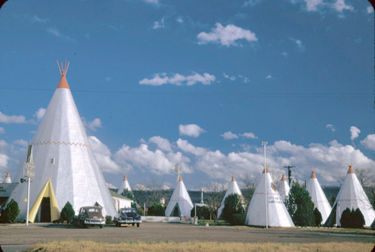Wigwam Village: Difference between revisions
No edit summary |
No edit summary |
||
| Line 2: | Line 2: | ||
The '''Wigwam Village''' was a tourist court which opened on [[Bessemer Super Highway]] ([[U. S. Highway 11]]) about 4 miles South of [[Bessemer]] in [[1941]]. It was the fifth in a chain of seven such tourist courts developed by Frank Redford of Horse Cave, Kentucky. Bessemer's wigwam village was operated by [[J. W. Davidson]], and later by Mr & Mrs [[Willis Staton]]. | The '''Wigwam Village''' was a tourist court which opened on [[Bessemer Super Highway]] ([[U. S. Highway 11]]) about 4 miles South of [[Bessemer]] in [[1941]]. It was the fifth in a chain of seven such tourist courts developed by Frank Redford of Horse Cave, Kentucky. Bessemer's wigwam village was operated by [[J. W. Davidson]], and later by Mr & Mrs [[Willis Staton]]. | ||
Redford built his first teepee-shaped restaurant in Horse Cave in the early 1930s and added 15 smaller guest-cabins in a horseshoe around it in [[1933]]. He patented his "wigwam village" concept in [[1936]] and built a second one in Cave City, Kentucky a year later. He then sold the blueprint to other operators. The third development was in New Orleans, Louisiana and the fourth, a larger version with 31 teepees, was constructed in Orlando, Florida. Birmingham's Wigwam Village #5 opened in [[1941]]. Later villages were opened in Holbrook, Arizona; Rialto, California. As part of the franchise agreement a coin-operated radio was installed in each room, with Redford collecting the coins as his commission. | Redford built his first teepee-shaped restaurant in Horse Cave in the early 1930s and added 15 smaller guest-cabins in a horseshoe around it in [[1933]]. He patented his "wigwam village" concept in [[1936]] and built a second one in Cave City, Kentucky a year later. He then sold the blueprint to other operators. The third development was in New Orleans, Louisiana and the fourth, a larger version with 31 teepees, was constructed in Orlando, Florida. | ||
[[Image:Wigwam village menu cover.jpg|left|125px]] | |||
Birmingham's Wigwam Village #5 opened in [[1941]]. Later villages were opened in Holbrook, Arizona; Rialto, California. As part of the franchise agreement a coin-operated radio was installed in each room, with Redford collecting the coins as his commission. | |||
The "village" consisted of a grouping of concrete "teepees", approximately 25' in diameter at the base. A larger teepee at the center served as a guest-registration office and cafe. The rooms were insulated and featured Native American themed hickory furniture and decor and complete baths. The exteriors were coated in aluminum paint with red zig-zag graphics. The cafe menu was printed on teepee-shaped paper. It featured all-day breakfast specials ranging from 35¢ to 50¢ and dinner specials from 40¢ to $1.10. | The "village" consisted of a grouping of concrete "teepees", approximately 25' in diameter at the base. A larger teepee at the center served as a guest-registration office and cafe. The rooms were insulated and featured Native American themed hickory furniture and decor and complete baths. The exteriors were coated in aluminum paint with red zig-zag graphics. The cafe menu was printed on teepee-shaped paper. It featured all-day breakfast specials ranging from 35¢ to 50¢ and dinner specials from 40¢ to $1.10. | ||
Revision as of 18:14, 2 April 2009

The Wigwam Village was a tourist court which opened on Bessemer Super Highway (U. S. Highway 11) about 4 miles South of Bessemer in 1941. It was the fifth in a chain of seven such tourist courts developed by Frank Redford of Horse Cave, Kentucky. Bessemer's wigwam village was operated by J. W. Davidson, and later by Mr & Mrs Willis Staton.
Redford built his first teepee-shaped restaurant in Horse Cave in the early 1930s and added 15 smaller guest-cabins in a horseshoe around it in 1933. He patented his "wigwam village" concept in 1936 and built a second one in Cave City, Kentucky a year later. He then sold the blueprint to other operators. The third development was in New Orleans, Louisiana and the fourth, a larger version with 31 teepees, was constructed in Orlando, Florida.
Birmingham's Wigwam Village #5 opened in 1941. Later villages were opened in Holbrook, Arizona; Rialto, California. As part of the franchise agreement a coin-operated radio was installed in each room, with Redford collecting the coins as his commission.
The "village" consisted of a grouping of concrete "teepees", approximately 25' in diameter at the base. A larger teepee at the center served as a guest-registration office and cafe. The rooms were insulated and featured Native American themed hickory furniture and decor and complete baths. The exteriors were coated in aluminum paint with red zig-zag graphics. The cafe menu was printed on teepee-shaped paper. It featured all-day breakfast specials ranging from 35¢ to 50¢ and dinner specials from 40¢ to $1.10.
The wigwam village closed in 1964 and the site was razed around 1970.
References
- Bryant, Walter (April 24, 2007) "Motel memories." Birmingham News
External links
- Redford's Patent #98617
- Roadside architecture at Birmingham Rewound
- Wigwam Motel at Postcard Birmingham
- Redford's Wigwam Villages at agilitynut.com
